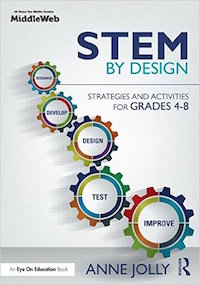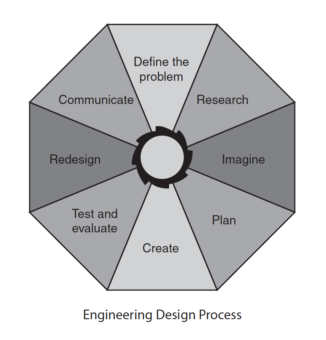A Must-Have Resource for Integrating STEM
STEM by Design: Strategies & Activities for Grades 4-8
By Anne Jolly
(Routledge/MiddleWeb, 2016 – Learn more)
Reviewed by Kathy Renfrew
I was hooked on STEM by Design right from the introduction when author Anne Jolly invites us to enter the world of 21st teaching and learning – a world that provides the perfect medium in which to design and facilitate project-driven STEM lessons and curriculum.
In that invitation I could see my dream taking shape – classrooms and schools where instruction and learning truly integrate the disciplines of science, technology, engineering and mathematics. In the past, during my days as a 5th and 6th grade teacher, I tried to achieve this level of integration without many tools or supports. What I would have given for STEM by Design then!

By briefly sharing some of this story, Jolly provides the reader with the “what it looks and sounds like” to grow a teaching practice that promotes student ownership of learning through challenging project-based lessons. Through her sharing, we see that “we” can do it too, especially if we use the tools she provides in this resource.
The intersection of STEM and NGSS
Teachers in states that have adopted the Next Generation Science Standards (and others in NGSS-friendly districts or classrooms) will totally love the intersection between the performance expectation of the Next Generation Science Standards and Jolly’s vision of STEM – the place where engineering, science, mathematics and technology are explicitly woven together!
This book can be extremely useful at a system, a school or a classroom level. At a systems and school level, the eight criteria of a STEM program can be used as a needs assessment, helping systems determine which of the criteria they are doing well and which they might need to devote more resources to. The STEM-plus and STEM-minus discussions in the book would also assist leaders in determining their strengths and weaknesses regarding STEM and where STEAM and other variations might fit.
This is a book for teachers
I especially love that this book was written for practitioners, for teachers in the classroom. The research is included, but STEM by Design is a manual to help classroom teachers make STEM a reality – not just one more discussion about how we might possibly include some more STEM in the curriculum.
Teachers will very much appreciate the resources provided in the book (and the companion website) that will help them provide quality learning experiences for students and which respect the “time” needed, an issue for most educators. There are concrete examples, templates and tools for choosing or creating a quality STEM lesson (the book describes how to use 28 design tools, downloadable here).
Jolly is a strong advocate of developing student teams within the STEM learning experience. In addition to her frequent teaming tips in the book, she has written a Student Teaming Guide for teachers to supplement her in-book advice.
The chapter on analyzing lessons for STEM potential I think will be of tremendous value. As teachers we can’t always start from scratch, but maybe we have lessons already that meet some of the criteria to be a STEM lesson. Looking closely at those lessons and adapting them will help move both teacher and student learning forward.
For example, as a teacher I might have good science/math problem. Is there a way I can include the engineering design process and perhaps some technology to make the learning a richer experience for students?
Prepping for STEM lesson creation
STEM by Design shares ideas to consider when you begin thinking about creating a STEM lesson. Two of Jolly’s preliminaries really struck home with me. First, make sure you are confident in your understanding of the big ideas and the content. I know as a science educator the importance of understanding the big ideas. Having this knowledge helps us as teachers anticipate students’ questions and better understand their thinking processes.

As she emphasizes, it’s more than just building; it’s planning, creating, testing, evaluating, redesigning and then communicating about your learning. The evaluate and redesign parts of the process ensure that students are engaged in higher level, complex thinking.
Value-added content
The inclusion of STEM FAQs and Practical Tips is a value-added portion of the book, as is the free content on the publicly available website. Jolly anticipates the questions and provides the answers to many of them in these resources. The information about connection to parents will be invaluable as educators move forward trying to implement STEM in their schools or classrooms.
With so much valuable information and useful tools in this book, I cannot begin to tell you about all of them. I can and I do highly recommend this book for any school district, any school or any educator who is trying to integrate STEM into their curriculum.
As I referenced earlier, I would have loved to have had this book as I began my own journey into STEM many years ago. Lucky you!
Kathy Renfrew, who taught grades 4 through 6 for many years in a self-contained classroom, confesses to once having been a “science phobic” classroom teacher. “I changed all that in the 90’s when I was introduced to inquiry science!” A National Board Certified Teacher and a 2000 recipient of the Presidential Award for Excellence in Science Teaching, Kathy is currently the K-5 Science Assessment Coordinator for the Vermont Agency of Education.




































